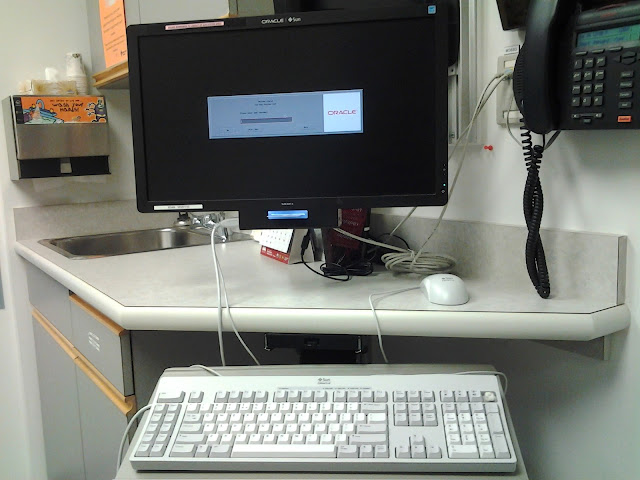Over the past five years I've spent time at eight different family practices and have seen much more edema, amongst other things. What was new about this family practice rotation was that it took place at a teaching clinic, attached to a community health centre. Rather than operating on a fee-for-service basis like most family doctors, the physicians here are salaried so that they may spend more time teaching residents and not have to worry quite as much about rushing through a high number of patients. It really was optimal. Plus it was pretty fun to be in a huge family clinic with seven staff physicians and half a dozen residents!
 |
| the community health centre |
 |
| the tricky part is charting efficiently while not completely ignoring the patient (my elementary school Mavis Beacon Teaches Typing efforts definitely paid off here) |
I worked Monday to Friday, spending time with each of the physicians in the clinic. The days looked pretty similar:
0740 h -- Head off to the clinic. Get stuck in traffic. Locate free parking on a neighbouring residential street.
0830 h - 1130 h or 1200 h -- See a patient every 15 or 30 minutes. Review with staff after seeing each patient.
1200 h - 1300 h -- Lunch time! Eat my yogurt/granola/banana while catching up on EMR charting.
1300 h - 1600 h -- See patients again, every 15 or 30 minutes.
1600 h - 1630 h -- Catch up on charting again.
1630 h -- Head home!
Nicely structured days, a real lunch break, and getting off before 5 pm were all wonderful things about the rotation. Furthermore, I did nine nights of home call -- and, get this, didn't get called a single time! Incredible.
Though it's easy to enjoy family practice for the reasons above, I really do like the work part of the specialty as well. And it is hard work. It's not easy to keep on a four-patients-an-hour schedule when things booked as "prescription refill" or "test results" turn into five-problem or crying-patient 45-minute visits. The upsides of a high volume practice are that you see a good variety of interesting things and leave at the end of the day feeling that you've been productive.
I'll just leave you with a list of things about family practice that I didn't properly realize before medical school:
- Family practice is not a default residency to fall back on if you don't match to your first choice of specialty. It is becoming increasingly competitive and a lot of Canadian programs tend not to even offer interviews to applicants whom they see have done five ENT electives and no family...so at least feign interest with a family elective or two if you're planning to "back up" with it.
- Family practice is hard. It's very general, so you have to know a bit about everything -- and, being the shortest residency program, you only have two years to learn it all. And no one seems to appreciate that, least of all the big-headed specialists.
- Family doctors run their own businesses. And guess how much business training we get in medical school? Nada. You've got to take care of everything from renting an office to buying paper towel to paying your MOA. And you've got to be smart about your expenditures...high overhead = low take-home pay.
- When a family doctor spends 10 minutes with a patient, they're usually spending another 10 or more minutes behind the scenes -- charting, ordering/reviewing investigations, referring to specialists, filling out forms, faxing in prescriptions, phoning colleagues, advocating to insurance companies...it's a lot more work than patients realize!
- There are lots of opportunities in family practice. Not only can you hang your shingle wherever you want to live (or locum, if you're not ready to settle down quite yet), you can tailor your practice to whatever fulfills your interests. You can do an extra year of training to work in emergency, specialize in maternity, or become a GP-anesthetist or GP-oncologist. You can dapple in surgery by surgical assisting or by doing your own minor procedures in the office. Really anyone can find a niche!
All in all, I think that family practice is a wonderful speciality that I'm sure I would have been happy in had the cards fallen differently.





great info
ReplyDeleteThis post really gave me a great glimpse into the life of a family medicine doctor! I appreciate how you broke down both the rewarding and challenging parts of the specialty. It's also surprising how much behind-the-scenes work family doctors do. Thanks for sharing your experience—sounds like a fulfilling career path! If you're looking for great healthcare, check out primary care doctors in Brooklyn who can help with your health needs.
ReplyDeleteExcellent article! Family Medical Insurance is truly essential for safeguarding your loved ones against unexpected healthcare expenses. It’s reassuring to know there are plans that provide comprehensive coverage for the entire family under one policy.
ReplyDelete